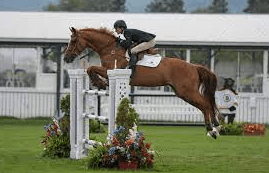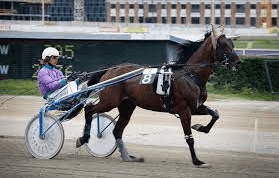What Are The Main Types Of Show Jumping Courses?

Show jumping is a thrilling equestrian sport that requires both skill and precision from both horse and rider. One of the key elements of show jumping is the course itself, which consists of a series of obstacles that must be cleared in a specific order and within a certain time limit.
There are several types of show jumping courses, each with its own unique characteristics and challenges.
The first type of show jumping course is the vertical course. This type of course features obstacles that are tall and narrow, resembling vertical walls. The height of the obstacles can vary, ranging from relatively low heights to towering heights that test the limits of a horse’s jumping ability. Vertical courses require horses to have excellent technique and agility, as they must clear each obstacle cleanly without knocking down any rails.
Another common type of show jumping course is the combination course. This type of course incorporates various combinations or sequences of jumps that require horses to navigate through them smoothly and efficiently. Combination courses often include related distances between jumps, requiring riders to adjust their horse’s stride length accordingly. These courses test both the athleticism and responsiveness of both horse and rider.
Lastly, there are technical courses which challenge riders with complex patterns or configurations. Technical courses often feature twists, turns, angles, or tricky lines between fences that demand accuracy in riding and precise communication between horse and rider. These courses require strategic thinking as riders need to plan their approach carefully in order to successfully navigate through the sequence.
In conclusion, show jumping offers an exhilarating experience for those who appreciate freedom in motion while also demanding discipline and precision from both horse and rider. Different types of show jumping courses present varying challenges such as vertical walls in vertical courses or combinations requiring efficient navigation skills in combination courses. Additionally, technical courses provide opportunities for strategic thinking while showcasing the agility and communication abilities required in this sport.
Vertical Courses
Vertical courses are a fundamental component of show jumping, allowing horses and riders to demonstrate their agility and precision in navigating the upright obstacles that demand meticulous control and calculated techniques.
Common challenges in vertical courses include accurately judging the approach and takeoff points, as well as maintaining balance and straightness throughout the jump.
Riders must also be mindful of their horse’s stride length and adjust accordingly to ensure an optimal distance between each fence.
Strategies for success in vertical show jumping courses involve effective communication between horse and rider, proper training to develop strength and flexibility, as well as mastering the art of timing and rhythm.
Additionally, riders should focus on maintaining a balanced position with relaxed hands, allowing the horse to freely use its body over the jump.
By practicing these strategies consistently, competitors can enhance their performance in vertical courses while showcasing their skillful execution of precise movements within this discipline of equestrian sport.
Combination Courses
Comprising a series of intricate obstacles strategically placed throughout the course, combination courses demand precision and agility from both horse and rider, fostering an exhilarating sense of anticipation among spectators.
These courses consist of various combinations that require careful navigation to maintain momentum and rhythm.
The challenges of combination courses lie in the complexity and sequence of jumps, testing the partnership between horse and rider.
To tackle these courses successfully, riders must employ effective strategies such as maintaining balance, adjusting stride length, and executing precise turns.
Timing is crucial when approaching combinations to ensure proper takeoff points for each jump.
Additionally, riders need to anticipate their horse’s reactions and make quick adjustments while maintaining control and communication.
By mastering these strategies, riders can navigate combination courses with finesse and achieve optimal performance in show jumping competitions.
Technical Courses
Technical courses challenge riders and horses with intricate and demanding obstacles, requiring precise execution and a deep understanding of the sport.
These types of show jumping courses are designed to test the skills of both the rider and the horse, pushing them to their limits in terms of accuracy, agility, and control.
The technical challenges presented on these courses often include tight turns, difficult combinations, delicate fences, and complex lines that require careful planning and quick decision-making.
Riders must have excellent communication with their horses and be able to adjust their riding technique accordingly to navigate through these challenging obstacles.
Additionally, riders need to possess a high level of fitness, as technical courses demand physical strength and stamina to maintain balance and control throughout the course.
Overall, technical show jumping courses provide an exciting spectacle for spectators while also showcasing the impressive skills and athleticism required by both horse and rider in this competitive equestrian discipline.
Frequently Asked Questions
How long does it typically take to set up a show jumping course?
Setting up a show jumping course typically takes a considerable amount of time, depending on the complexity and size. It involves arranging various equipment such as jumps, poles, and markers in a meticulous manner to create an engaging and challenging course for both horses and riders.
What are some common mistakes riders make on vertical courses?
Common mistakes riders make on vertical courses include poor approach angles, lack of impulsion, and incorrect timing. To improve, riders should focus on maintaining a balanced position, establishing clear communication with their horse, and practicing precise riding techniques.
Are there any specific rules or regulations for combination courses?
Specificity in combination courses is crucial for show jumping riders. These courses require a precise jumping technique, where horses navigate a series of obstacles with fluidity and accuracy. Strict rules and regulations ensure the fairness and safety of these challenging courses.
How do technical courses differ from other types of show jumping courses?
Technical show jumping courses are designed to challenge the skills and abilities of both horse and rider. They often feature complex combinations, tight turns, and difficult distances between jumps. Riders must employ strategies such as accurate riding lines and precise control to navigate these courses successfully.
Are there any specific challenges or obstacles that riders often face on technical courses?
Specific challenges and obstacles that riders often face on technical show jumping courses include tight turns, complex combinations of jumps, adjustable distances between fences, and the need for precise timing and control. These elements test the rider’s skill, accuracy, and ability to make quick decisions.
Conclusion
Show jumping courses can be classified into three main types:
- Vertical courses consist of a series of jumps that are set up as single obstacles without any related elements. These jumps require the horse and rider to have good technique and control in order to clear them successfully.
- Combination courses, on the other hand, involve a sequence of jumps that are placed close together, requiring the horse and rider to navigate through them smoothly and quickly.
- Finally, technical courses challenge the horse and rider with complex obstacle arrangements that may include tight turns, tricky angles, or unusual combinations.
In conclusion, show jumping courses come in various forms that test different skills of both the horse and rider. Just like a skilled artist carefully chooses their brushstrokes to create a masterpiece on canvas, show jumpers must carefully navigate these diverse courses with precision and finesse.
Each type of course presents its own set of challenges for the horse and rider duo to overcome. Whether it is gracefully soaring over tall verticals or skillfully maneuvering through intricate combinations, show jumping requires both athleticism and artistry from its participants. It is truly a captivating sport where horses become dancers on an obstacle-filled stage, showcasing their talent in an elegant performance for all to witness.




